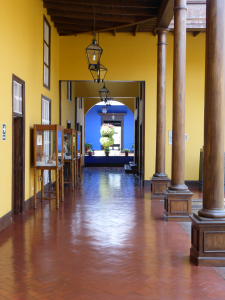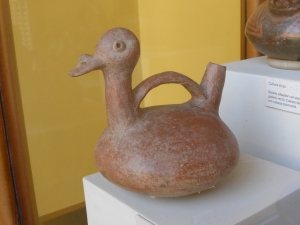The Plaza de Armas – the main square in Trujillo is a stone’s throw away from where I am currently living in a home-stay. The massive square is dominated by a large central sculpture with fountains and statues and is surrounded by vividly coloured buildings which squat around its perimeter. The sky blue and white of the town hall vies with the glaring gold of the magnificent cathedral in the opposite corner. Terracotta, royal blue and eye-searing whites add to the palette whilst multi-coloured flags and palm trees flap in the strong breeze.
Casa de Urquiaga is a compact but beautiful museum (free entrance) which is housed in a curious location. People queue to gain access through tight security to a courtyard off which is housed an outlet for the Banco Central de la Reserva del Peru. After showing my passport I was allowed past the bank and through to the inner sanctum where a series of small courtyards are surrounded by a small number of rooms stuffed with dark brown wooden furniture and paintings.
I usually whizz past any displays of pottery in a museum but the small collection of pots and jugs here really slowed me down. They were collected from the various regions of Peru and were mostly in the image of little fat people or strange creatures and were oddly endearing.
The bare brown mountains form a backdrop to the square, rearing up out of the strange hazy mist that appears to sit over the entire coastal area of the city and the whole square reverberates to the din of traffic horns and sirens.
On Sunday I went with a couple of friends to visit the complex at Huacas del Sol y de la Luna (the temples of the sun and the moon) which was a bone shaking taxi ride a few miles outside the city. The Cerro Blanco mountain dominates the dusty sandy landscape, rising out of the desert and towering over the surrounding desert and the two temples. It is an excellent museum containing shed-loads of the little terracotta pots which I had so fallen in love with and it occupied us for a good hour. The pots were all in pristine condition and excellent and interesting wall posters explained and described how the artifacts which were on display portrayed the Moche way of life. The Moche society had its heyday between 100 and 800AD and was a society ruled by priests. As leaders they structured the lives of the population around the temples, performing many human sacrifices to appease the mountain god who they believed controlled the weather (among other things), with the sacrifices ramping up during periods of increased el niňo activity. We then had a guide around the Temple of the Moon – in Spanish – and were shown initially around clusters of adobe (mud) bricks. We were then taken into a covered area where we saw mosaics and frescos on the walls. The colours were so bright and fresh it was hard to believe that they hadn’t been touched up at all. There were large portions of the wall painted with repeating patterns of the mountain god and then behind the whole structure, the entire gable end was decorated with murals and scenes. My photographs simply don’t do the colours or the size justice. You really should come and visit and see for yourself. The Temple of the Sun is currently closed to visitors due to on-going excavation work but that in itself is an impressive sized sandy hump. Between the two temples you can see the outlines of what would have been the buildings of the town traced out in patterns of excavated bricks on the desert floor.
There was a lovely little artisan market in the courtyard selling replica pots, jewellery and clothing and also one of the Peruvian hairless dogs was lying in the sun. This one was an eleven month old puppy. The breed has no fur but the skin of the dog is amazingly hot – they were bred and kept in part to keep people warm in winter or would be cuddled so that the heat would relieve arthritis. This particular dog only had two teeth and its owner was proud to show it off. I couldn’t establish whether the lack of teeth just related to this particular dog – but I have since found out via good old Wikipedia that lack of teeth is a characteristic of the breed.
On the other side of Trujillo over by the airport, Huanchaco beach sprawls along the coastline. This beach resort has its obligatory parade of shops, hostels and restaurants, a pier and a good little craft market tucked away down a tiny alleyway. There is a pier and it attracts surfers and travellers from all over the world. Racks at the back of the beach contain dozens of reed canoes which are propped up to dry out in the sun. These boats date back to pre-Inca times and were first used by the Moche culture. The people of Huanchaco are the only ones who still know how to make them which is just as well as each boat only lasts a few months before becoming waterlogged.






How lovely to read your descriptions of your area, how is the teaching going? Am up to my knees in cow sh*t believe me these things can dirty an area within a few hours of it being scraped and straw disappears into a brown sodden mess. A cow with horns has just calved and is being a bit of a nusiance, chasing anything that goes near the calf and is particularly disliking of the llama. How will you spend Christmas? Will come back later to write some more. Dead cow to move.
I so enjoy reading your blogs Jane. Your descriptive writing is so compelling to read. What incredible memories you will have
Thank you Carol. I still pinch myself most mornings as I walk to work and realise that I am actually in Peru. It is an assault on the senses and you need to keep your wits about you, but I am loving it. I am so pleased that you are enjoying my writing
We are thoroughly enjoying every blog too and definitely wish we were enjoying all these experiences with you. Our time will come!!! AM&D
Hiya, I’m learning Geography & History from you blog and loving it. Perhaps this is the way to teach school children? The Moche sound quite like old Druids, very interesting bud! XXXXXXXXXX